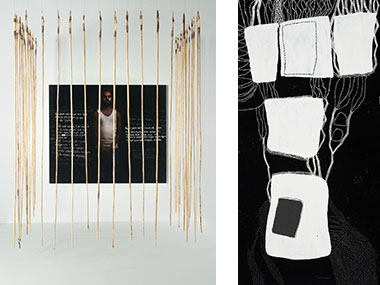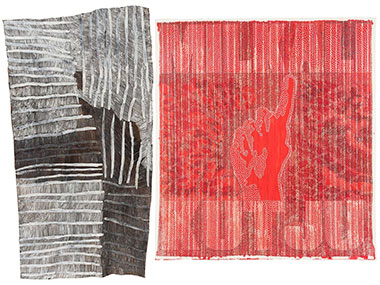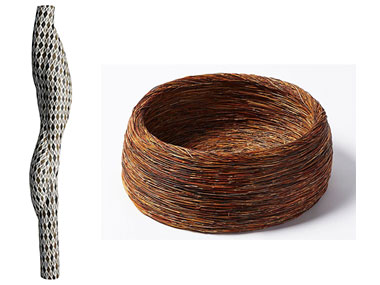Natsiaas 2017

(L) Big Telstra Award-winners Unrupa Rhonda Dick, Frank & Anwar Young's work, a photo of Anwar as a troubled youth surrounded by Pitjanjatjara text and work encased in a protective wall of wooden spears. (R) Nongirrnga Marawili with a giant lightning pain
Jeremy Eccles | 11.08.17
Given the anniversaries celebrated this year - the 1967 Referendum, the Mabo verdict, etc - and the recent Uluru Statement process, it was perhaps inevitable that the 2017 NATSIAAs would feel profoundly political. And that's not just the Big Telstra winner - the collaborative work by Frank and Anwar Young, photographed by Unrupa Rhonda Dick - but in the cross-generational aspect of a work like that. The old artists are handing on the baton to a new generation, as Aboriginal artist and judge, Regina Wilson wanted to emphasise.
"Spears were in constant use when Frank was young", she explained; "in hunting and ceremonies. For young boys today, they're about balance more than aggression; the maintenance of law and consistency. So that wall of spears isn't a prison cell but a protective boundary for young men, not forgetting their mothers and sisters who need to be protected by the men".
So the big winner of both the top prize and the new Multimedia Award - entitled Kulata Tjuta - Wati kulunypa tjukurpa (Many spears - Young fella story) - was a striking photo of Anwar as a potentially troubled youth (think Don Dale), surrounded by Pitjanjatjara text, the work encased in a wall of wooden spears. Frank Young may have been the concerned Amata elder behind the project, but grandson Anwar was last year's NATSIAA youth winner with a forest of decorated spears, and niece Rhonda has had several solo photographic shows.
The judges - Wilson, QAGoMA Director, Chris Saines, and independent curator, Emily McDaniel - felt that this was not only a pertinent work for the times but a response to them, offering the possibility of a solution rather than a despairing cry.
Appropriately, on a wall nearby, the man who first brought spears and text into artistic prominence, Mumu Mike Williams, had a triptych of recycled mailbags making bold land rights claims, though he stood before them to claim that the spear from which they hung represented the weapons handed in at the end of hostilities in order to make peace. The Makarrata ceremony proposed at Uluru would traditionally have employed the same symbolism.
Three of the other Telstra Awards came from this same fruitful APY Lands area. Perennial prize winner Robert Fielding took out Works on Paper with his peace-cry, Milkali Kutju - One Blood, emphasising "peace, love and joy; not hate or fear" between races. Amazingly the judges picked it before its stunning lightbox was turned on to outline his message. Then, both General Painting (Matjangka Norris's grey and white drought work) and the newly defined Emerging Artist prize for a mature Betty Muffler seeking the healing needed after the Maralinga bombs despoiled her Country, were proud Anangu women.
Shirley Macnamara's woven spinifex basket appeared to be simply gleaming perfection in construction. But even here, the 3D Award-winning artist had a political link between her culturally-fearful grandmother and the 'Old Woman Spinifex' material, as it's known around Mt Isa. Sadly, even the '67 Referendum didn't give Macnamara her grandmother's language. Perhaps only Nyapanyapa Yunupingu's mighty, textured Telstra-winning bark work lacked contemporary politics. The bold, black and white (again) linear work represented 'gurtha', the life-giving force of fire to her.
I have to say that I was more excited by Yunupingu's fellow-Yolngu, Dhuwarrwarr Marika's bark, Milngurr in this contest. But it failed to even make the NATSIAA cut, appearing in the Salon des Refuses, an increasingly serious rival to the main show. Significantly, the Museum and Art Gallery of the NT had reverted to its former policy of separating the pre-selectors of 63 finalists from 300 NATSIAA entries from the final judges For three years, MAGNT Indigenous curator, Luke Scholes will make the first cull with Sydney curators Hetti Perkins and Clothilde Bullen. Some continuity is intended, according to MAGNT director, Marcus Schutenko.
Is the result an unquestionable triumph? Of course not. Art's not like that. Before I'd seen the main show, I counted 12 works in the Salon that looked award-worthy. But, whereas I might have favoured representation for the newly restored Anindilyakwa art centre on Groote Eylandt (in the persons of the Lalaras, uncle and niece), clearly the pre-selectors prioritised wonderful old artists like Nyarapayi Giles, Nada Rawlins and Neville Mcarthur for their past contributions. I understand.
I'm less confident that the finalist judges felt that their stated priority to reward "works by artists that were moving forward" had really been met by the pre-selection of predictable artworks by some Papunya Tula artists, photographers Christian Thompson and Gary Lee, and painters Timothy Cook, Tommy May, Tjungkara Ken and Harold Thomas, playing again on his last year's winning hyper-real style.
Clearly moving forward in my eyes, on the other hand, were Nongirrnga Marawili with a giant lightning painting on aluminum, Gunybi Ganambarr's sensual, body-shaped larrikitj, Nyurapaya Kaika Burton's totally textual family tree, and Yalti Napangati's Papunya Tula work that eschewed op-art lines by cleverly harking back to the symbols that first appeared on the original Papunya boards that are on show for the first time in aeons downstairs at MAGNT in Tjungunutja - probably the most important art show in the country currently.
You have until October to get to the NATSIAAs, to September 30 to make the Salon at Charles Darwin University, and until the New Year to appreciate the magical development of the whole acrylic and ochre project in Tjungunutja. Darwin is definitely worth a visit.
Share this:
»  del.icio.us
»
del.icio.us
»  Digg it
»
Digg it
»  reddit
»
reddit
»  Google
»
Google
»  StumbleUpon
»
StumbleUpon
»  Technorati
»
Technorati
»  Facebook
Facebook
Contact Details
Gallery: National Aboriginal and Torres Strait Islander Art Award
Telephone: +61 8 8999 8264
Address: 19 Conacher Street Fanny Bay Darwin 0820 NT
Gallery: Museum and Art Gallery of the Northern Territory
Contact: Marcus Schutenko
Email: info@magnt.net.au
Telephone: +61 8 8999 8264
Address: 19 Conacher Street Fanny Bay 0820 NT

(L) Nyapanyapa Yunupingu's winning bark. The bold, black and white linear work represented 'gurtha', the life-giving force of fire to her. (R) Robert Fielding Works on Paper winner, Milkali Kutju - One Blood.

(L) Gunybi Ganambarr's sensual, body-shaped larrikitj.(R) 3D Award-winning artist Shirley Macnamara's woven spinifex basket - perfection in construction.
Further Research
Gallery: National Aboriginal and Torres Strait Islander Art Award
Artists: Anwar Young | Betty Muffler | Christian Thompson | Dhuwarrwarr Marika | Frank Young | Gary Lee | Gunybi Ganambarr | Harold Thomas | Matjangka Norris | Mumu Mike Williams | Neville Mcarthur | Nongirrnga Marawili | Nyarapayi Giles | Nyurapaya Kaika Burton | Regina Wilson | Robert Fielding | Shirley Macnamara | Timothy Cook | Tjungkara Ken | Tommy May | Unrupa Rhonda Dick | Yalti Napangati
News Tags: Big Telstra | Chris Saines | Clothilde Bullen | Don Dale | Emily McDaniel | Hetti Perkins | Jeremy Eccles | Luke Scholes | MAGNT | Maralinga | Marcus Schutenko | Museum and Art Gallery of the NT | NATSIAA | Regina Wilson | Salon des Refuses
News Categories: Art Fair | Art Prize | Australia | Blog | Event | Industry | News
News Archive
- 19.11.18 | Two Iconic Art Galleries for the NT?
- 17.11.18 | Passing Clouds
- 13.11.18 | The Uluru Statement comes to Sydney
- 05.11.18 | Skye's the Limit
- 31.10.18 | DO WE WANT AN INDIGENOUS ARTS AUTHORITY?
- 29.10.18 | MAJOR INDIGENOUS COMMISSION FOR THE ASIAN STAGE
- 17.10.18 | Tommy Watson in Sydney
- 10.10.18 | The Aboriginal Memorial – A Smouldering Reproach
- 03.10.18 | Closing the Craft Circle
- 25.09.18 | OCEANS APART
- 13.09.18 | SYDNEY CONTEMPORARY 2018
- 11.09.18 | Alice Springs Gallery Project – Mixed Views
- 05.09.18 | The Museum Race Hots Up
- 03.09.18 | Mawurndjul Makes Headlines in DC
- 24.08.18 | Whispering Still
Advertising

